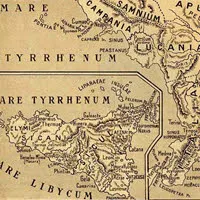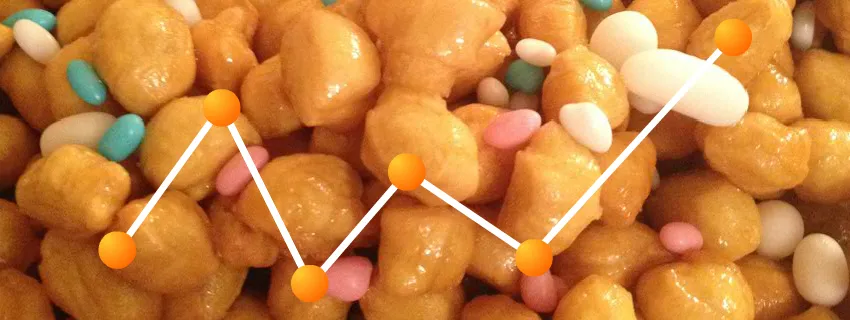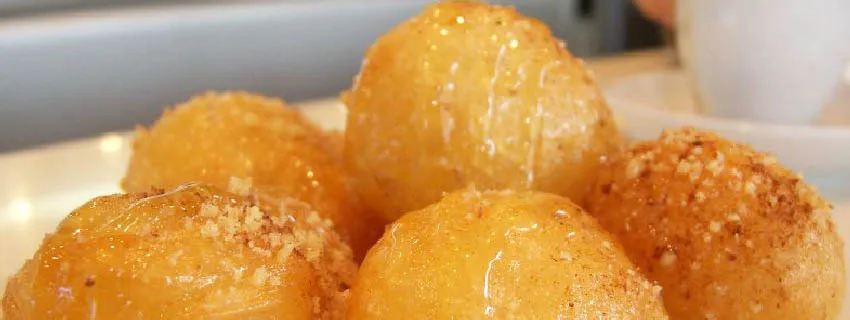Published:
Author: Antonio Maria Guerra
Neapolitan Struffoli
HISTORY, INFO, PLACES, INTERESTING FACTS

Although Struffoli were not invented in Naples, being the result of the contamination of ancient gastronomic cultures, over the centuries they gradually became ambassadors of Neapolitan taste in Italy and around the world, together with equally famous desserts such as Babà and Pastiera. Let’s find out the history of this specialty, its preparation and a large number of sweet curiosities. Enjoy the reading!

What are Struffoli?
Struffoli (singular: ‘Struffolo’), are the Neapolitan variant of a sweet specialty widespread, with different names and specific characteristics, in a great part of the Mediterranean countries: from Spain to Greece, up to Turkey. Something very similar can be found in many regions of Southern Italy. In the ‘City of the Sun’, Struffoli are the dessert usually served at the end of the lunches and dinners that dot the Christmas and New Year holidays.

Neapolitan Struffoli
THE MOST TRADITIONAL PASTRY SHOP
This article is the result of collaboration between WebFoodCulture and Pasticceria Scaturchio, the most traditional producers of Neapolitan Struffoli.


The history of Neapolitan Struffoli.
 The origins of Struffoli have long been a matter of debate among scholars: however, it’s almost certain that they are not from Neaples, being rather linked to the historical contacts of the city with the countries bordering the Mediterranean basin and with the Arab world. (*1).
The origins of Struffoli have long been a matter of debate among scholars: however, it’s almost certain that they are not from Neaples, being rather linked to the historical contacts of the city with the countries bordering the Mediterranean basin and with the Arab world. (*1).
Many attribute the paternity of the dessert to the Greeks of the classical era: in support of this hypothesis, it’s important to remember that ‘Neapolis’ (*2) was one of the major centers of Magna Graecia (*3) and that, still today, this people count among its most traditional specialties something very similar: the ‘Loukoumades’.
Another theory suggests that Struffoli could be an evolution of the ‘Globulos’, spherical fritters cooked in lard and sprinkled with honey, very popular in ancient Rome (*4).
Lastly, some experts argue that the ancestor of this dessert was introduced in Naples by the Spaniards during their dominion over the city, starting from the sixteenth century. In this regard, it should be noted that, nowadays, in Andalusia (*5), it’s possible to savor something very similar: the ‘Piñonate’.
Read more
Regardless of the genesis, it’s almost certain that starting from the Middle Ages, it was the nuns of the many Neapolitan convents who preserved (and sometimes evolved) the tradition of Struffoli in the city (*6): on the occasion of festivities, they used to donate them to noble families so as to enter into their graces.
These days, Struffoli are one of those delicacies that must not be missed from the table of every true Neapolitan during the Christmas holidays: eating them on New Year’s Eve is not just a pleasure but also a good omen gesture.
Notes:
*1: It’s no coincidence that honey, a fundamental ingredient in the preparation of Struffoli, is equally fundamental in a large number of Arab specialties;
*2: ‘Neapolis’: ancient name of the city of Naples. Its English translation is ‘New City’ (from the greek Nea-Polis);
*3: ‘Magna Grecia’ was the area of the Italian peninsula colonized by the Greeks starting from the eighth century BC;
*4: An interesting hypothesis. However, considering the close link between the Hellenic and Roman civilizations, it would be more appropriate to link it to the former;
*5: The ‘Piñonate’ made in the zone of Extremadura (Andalusia) is very similar to Struffoli. The main difference is the shape of the little pieces, which is oblong rather than spherical;
*6: This is not surprising: a great part of the Neapolitan confectionery tradition (and not only), is in some way linked to the monastic institutions of the city (a good example is the famous ‘Pastiera’);
Naples, the city of Struffoli.
Naples, the capital of the Italian region of Campania, can boast very ancient origins: these are generally traced back to the eighth century BC, when it was known by the Greek name of ‘Neapolis’ (‘New City’).

The size of Neapolitan Struffoli.
Some may wonder why the small balls that constitute Struffoli are so small in size.
Read more
It’s quickly explained: these dimensions, by considerably increasing the surface, allow the dessert to be seasoned with a greater amount of honey, all to the benefit of its taste. It should be also emphasized that this abundance has a strong religious connotation.

Neapolitan Struffoli: ingredients and preparation (hints).
Although many Neapolitan families pass down from generation to generation their own ‘secret recipe’ for Struffoli, in this article we prefer to illustrate the most classic method of preparation, with the precious help of the pastry shop that, nowadays, can be considered the custodian of the tradition of this specialty (*1): Scaturchio.

DOUGH:
- Sugar (200 gr.);
- Flour type “00” (1kg);
- Margarine (150 gr.);
- Whole eggs (6);
- Egg yolks (6);
- Alcohol (50 gr.);
- Vanilla;
- Salt (6 gr.);

GARNISHING:
- Honey (1,2kg: it’s quality is VERY IMPORTANT)
- Water (150 ml)
- Sugar (600 gr.)
DECORATION:
- Candied fruit cut into small pieces (300 gr.)
- Confetti ‘diavolilli’
PREPARATION (hints):
- Make a uniform and compact dough with the ingredients listed above;
- Detach the pieces from the dough and manually prepare a series of finger-thick strips;
- Cut the strips into small pieces;
- Fry the pieces until they get a nice golden color;
- Mix the Struffoli with the garnish and add only a part of the candied fruit and the ‘diavolilli’;
- Place the Struffoli on a plate and decorate them with the candied fruit and the remaining ‘diavolilli’;
Note:
*1: Since it’s the oldest pastry shop specialized in its preparation and still in business.


‘Struffoli’: the origins of the name.
As already mentioned in another paragraph of this article, there is no evidence regarding the origins of Struffoli: by the way, the etymology of their name would seem to indicate that, most likely, they are Hellenic.
Read more
The word ‘Struffolo’ could derive from the Greek ‘στρόγγυλος’ (‘stróngylos’), which English translation is ‘round’ or ‘rounded’, with a clear reference to the shape of the small balls, the ‘Struffoli’, constituting the dessert.

‘Diavulilli’ to decorate Struffoli.
One of the elements that most characterize the appearance of Struffoli is the use of ‘Diavolini’ (in Neapolitan ‘Diavulilli’) as decoration.
Read more
They are small confetti, mostly made of sugar: with their bright colors, they further improve the aspect of an already very particular specialty, making it the holiday’s dessert par excellence.

Neapolitan Struffoli: calories and nutritional values.
It’s quite difficult to indicate precisely the number of calories in a portion of Neapolitan Struffoli: this obviously depends on the quantity of honey and ‘diavulilli’ used.
Read more
We can say that, on average, 100 grams of this specialty contain between 400 and 500 kilocalories.
As for the nutritional values, here follow the (approximate) percentages:
- Carbohydrates (70% approx.)
- Proteins (15% approx.)
- Fat (15% approx.)

The ‘other’ Struffoli.
As already mentioned in this article, Struffoli are the Neapolitan ‘variant’ of a dessert belonging, in similar forms, to the gastronomic traditions of many Mediterranean and Middle Eastern countries. It’s therefore not surprising that in Italy itself (especially in the south), similar preparations can be found, whose origins are rooted in the same past. Some examples:
Read more
- The ‘Strufoli’ (with one ‘f’) from Palermo;
- The ‘Cicerchiata’, widespread in the regions of Molise, Abruzzo, Marche and in part of Lazio. Similar to Struffoli, it’s made of smaller pieces;
- The ‘Cicerata’ or ‘Cicirata’, from the region of Basilicata. Its name comes from the fact that the balls are so small that they look like chickpea (In Italian: ‘Ceci’);
- The ‘Pignolata’ with honey, widespread in the regions of Calabria and part of Sicily. Its name comes from the ‘pine cone’ disposition of the small pieces of which it is composed;
- The ‘Sannacchiudere’, widespread in the province of Taranto. Its name comes from the legend in which a mother, to prevent her children from eating the dessert too soon, had to lock them in the pantry (the English translation of ‘Sannacchiudere’ is ‘must be locked’);
- The ‘Purceddhruzzi’, widespread in the province of Lecce. Their name comes from the fact that they vaguely resemble small pigs (the English translation of ‘Purceddu’ is ‘pig’);
- The ‘Giggeri’, a specialty from Carloforte, a town located in the Province of Carbonia-Iglesias, in southern Sardinia;

The right wine for Neapolitan Struffoli.
One of the best choices to accompany a tasty portion of Struffoli could certainly be a Passito di Pantelleria, preferably with good acidity. Its sweetness will balance that of the Neapolitan specialty, its acidity will make it not cloying.

The ‘Loukoumades’.
The ‘Loukoumades’ (also known as ‘Lokma’, whose translation from the Arabic language is ‘bite’), are a specialty available, with small differences, in some countries of the Middle East, in Turkey, Cyprus, and Greece. Some experts speculate that ‘Struffoli’ could be an evolution of one of its variants, much appreciated still today in the Hellenic peninsula
Read more
Not surprisingly, this consists of balls of sweet dough, fried and covered with a thick layer of honey syrup. Characteristics it has in common with the Neapolitan dessert (*1).
Notes:
*1: It’s important to stress the fact that ‘Loukoumades’ differ from Struffoli in size (quite bigger), softness and in being garnished with chopped walnuts rather than candied fruit and small confetti (‘diavolilli’).

Are Struffoli a Christmas dessert?
Some scholars are not so sure that, in Naples, ‘Struffoli’ have always been a Christmas dessert: as proof of this, they usually quote a book dating back to 1634, entitled ‘Lucerna de corteggiani’, written by Giovanni Battista Crisci, in which the specialty is mentioned (along with many others), but not concerning this particular anniversary.

Pasticceria Scaturchio: contacts.
Address: P.zza S. Domenico Maggiore, 19
80134 Naples – Italy
Website: www.scaturchio.it
Mail: info@scaturchio.it
Tel.: +39 081 551 7031
Copyright information.
The images displayed in this page belong to WebFoodCulture and to Pasticceria Scaturchio, with the exception of:
Public Domain Images
- Greek colonies in Italy and Sicily (Wikipedia Link)
Creative Commons Images
- Loukoumades, image by Avlxyz (Wikipedia Link)




